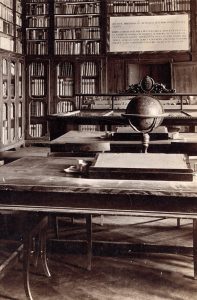The donation and the first venue
ONOFRIO BALDELLI and GIANGASTONE DE’ MEDICI
The Museum was founded in 1727, when the Abbot Onofrio Baldelli donated his Museum and his Library to the Institution, promoted by his nephews Marcello, Filippo and Ridolfino Venuti who had gathered together with other noblemen of Cortona to build a society, an academy of sciences and erudition.
The venue on the highest floor of Palazzo Casali was granted by the Grand Duke of Tuscany Giangastone de’ Medici; after a long series of restoration and adaptation works, in 1753, both the Museum and the Library were located here, connected by the purpose of cultural promotion that was the same aim of the Accademia.
To the initial donation of objects, made by Onofrio Baldelli, a significant proportion of objects were added to the collection during the 18th century. These were above all archaeological objects, donated by the Members or Lucumones of the Accademia. Traditionally, the Lucumones were expected to donate their portrait. The porcelain shrine donated by Lucumo Ginori in 1756 is unique and precious, representing the glories of Tuscany.
Accademia Etrusca
A REPUTATION BEYOND BORDERS
The bustling collecting activities made the Accademia Etrusca famous, also and above, beyond borders thanks to the numerous Italian, French, English and German scholars who joined the Accademia through the years.
After the unity of Italy, starting from 1874, the life of the Accademia identified with its librarian, curator of the Museum and then Lucumo, Girolamo Mancini. He was particularly active in the bibliographical field and, thanks to him, the Museum grew significantly: at the end of the century Guido Corbelli, bishop of Cortona, bequeathed his collection of Egyptian objects to the Museum. It represented one of the most significant Egyptian collection in Italy.
The historical events that have occurred from the beginning of the 20th century and the end of the Second World War had only partially negative consequences on the Museum, which also acquired many objects, above all with the Tommasi-Baldelli bequest. At the end of the forties, the Museum was definitely extended to the noble floor of Palazzo Casali. In more recent times, the Museum has been further enriched with a precious collection of Gino Severini’s artworks, one of the promoters of Futurism.
The Museum changes appearance
FINDS FROM THE MELONE OF SODO
A further step in the collection enrichment process is represented by the moment when the Soprintendenza Archeologica per la Toscana gave to the Accademia the restored finds coming from the “Melone del Sodo” in 1995. This led to a further wide transformation of the Museum that has deeply changed its appearance and enriched its content.
This is how, in 2005, the old Museum became the MAEC, Museo dell’Accademia Etrusca e della Città di Cortona. From the very first weeks of opening it has been a great success and gives back the reputation, never faded, to Cortona, a constantly evolving center of great cultural importance.



